Rear Brake Rotor Replacement LHD
Removal Procedure
- Inspect the fluid level in the brake master cylinder reservoir (1).
- Disengage the park brake.
- Raise and support the vehicle. Refer to Lifting and Jacking the Vehicle .
- Remove the rear wheels. Refer to Tire and Wheel Removal and Installation .
- Install two wheel nuts in reverse (3) to opposite wheel studs to retain the brake disc to the hub.
- Install large G-clamp over the body of the brake caliper (1).
- Tighten the G-clamp until the brake caliper piston bottoms out in the brake caliper bore.
- Remove the G-clamp from the brake caliper (1).
- Remove and discard the brake caliper anchor plate to knuckle retaining bolts (2).
- Remove the brake caliper (1) from the knuckle (3).
- Support the brake caliper (4) with heavy mechanic's wire, or equivalent (3).
- Remove the two wheel nuts (2) retaining the brake disc (1) to the hub (5).
- Matchmark the position of the brake disc (2) to the wheel studs (1).
- Remove the brake disc (2).
Caution: Refer to Safety Glasses Caution in the Preface section.
Caution: Refer to Vehicle Lifting Caution in the Preface section.
Caution: Refer to Brake Dust Caution in the Preface section.
Caution: Refer to Brake Fluid Caution in the Preface section.
Caution: Refer to Brake Fluid Irritant Caution in the Preface section.
Notice: Refer to Adding Fluid to the Brake System Notice in the Preface section.
Notice: Refer to Brake Fluid Effects on Paint and Electrical Components Notice in the Preface section.

| • | If the brake fluid level is midway between the maximum fill level and the minimum allowable level, no brake fluid needs to be removed from the master cylinder reservoir (1) before proceeding. |
| Important: DO NOT completely empty the master cylinder reservoir (1) or remove any brake lines otherwise complete bleeding of the braking system will be necessary. |
| Important: DO NOT re use the removed fluid. |
| • | If the brake fluid level is higher than midway between the maximum fill level and the minimum allowable level, syphon the brake fluid to the midway point using a hand vacuum pump (2) before proceeding. |
| Important: Make sure the park brake is fully released. |

Important: Position the ends of the G-clamp against the rear of the brake caliper (1) and against the outboard brake pad (2).
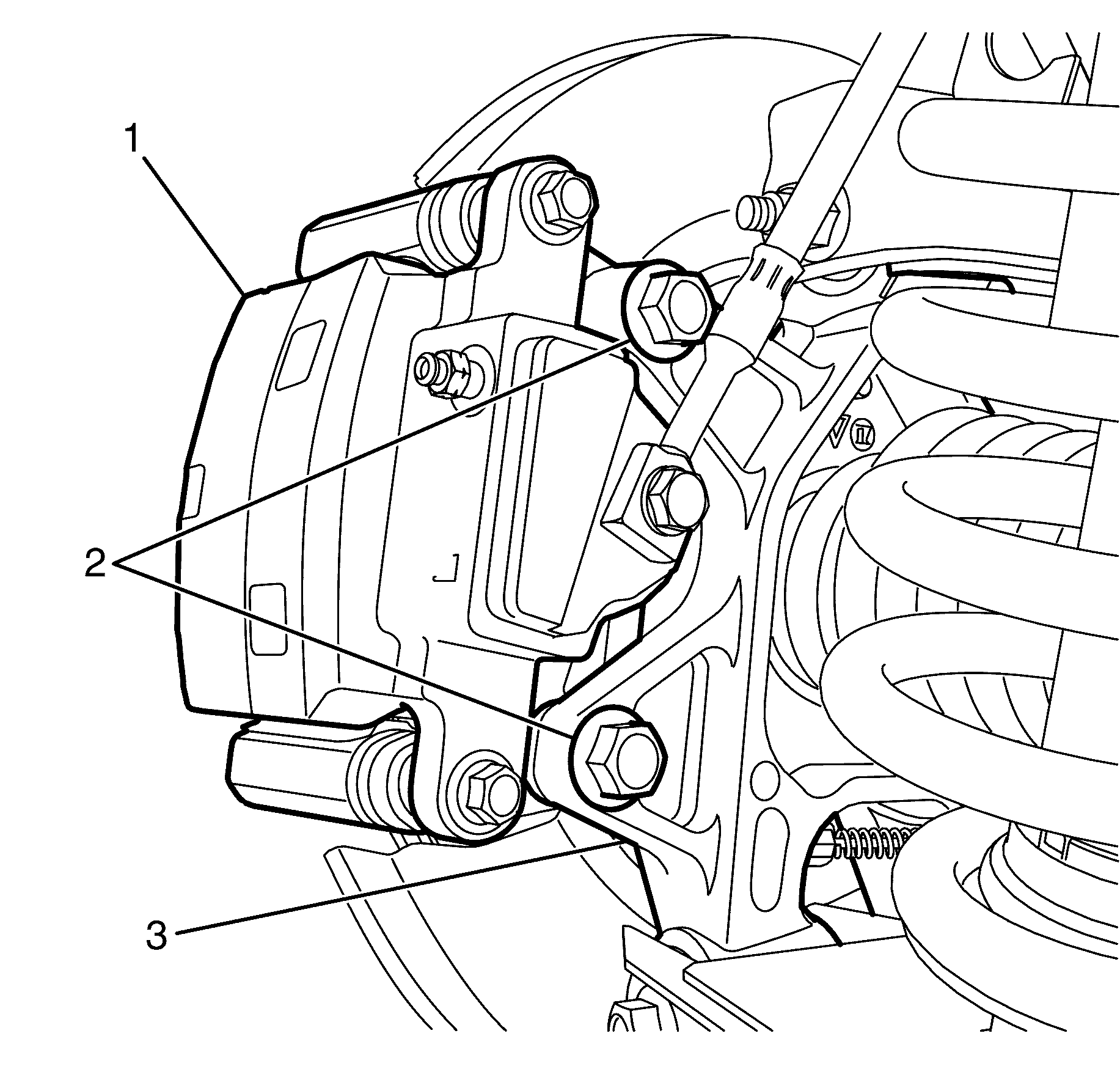
Important: Bolts with micro-encapsulated thread sealant must be discarded after removal.
Important: DO NOT disconnect the hydraulic brake flexible hose from the brake caliper otherwise complete bleeding of the braking system will be necessary.
Notice: Refer to Brake Caliper Notice in the Preface section.
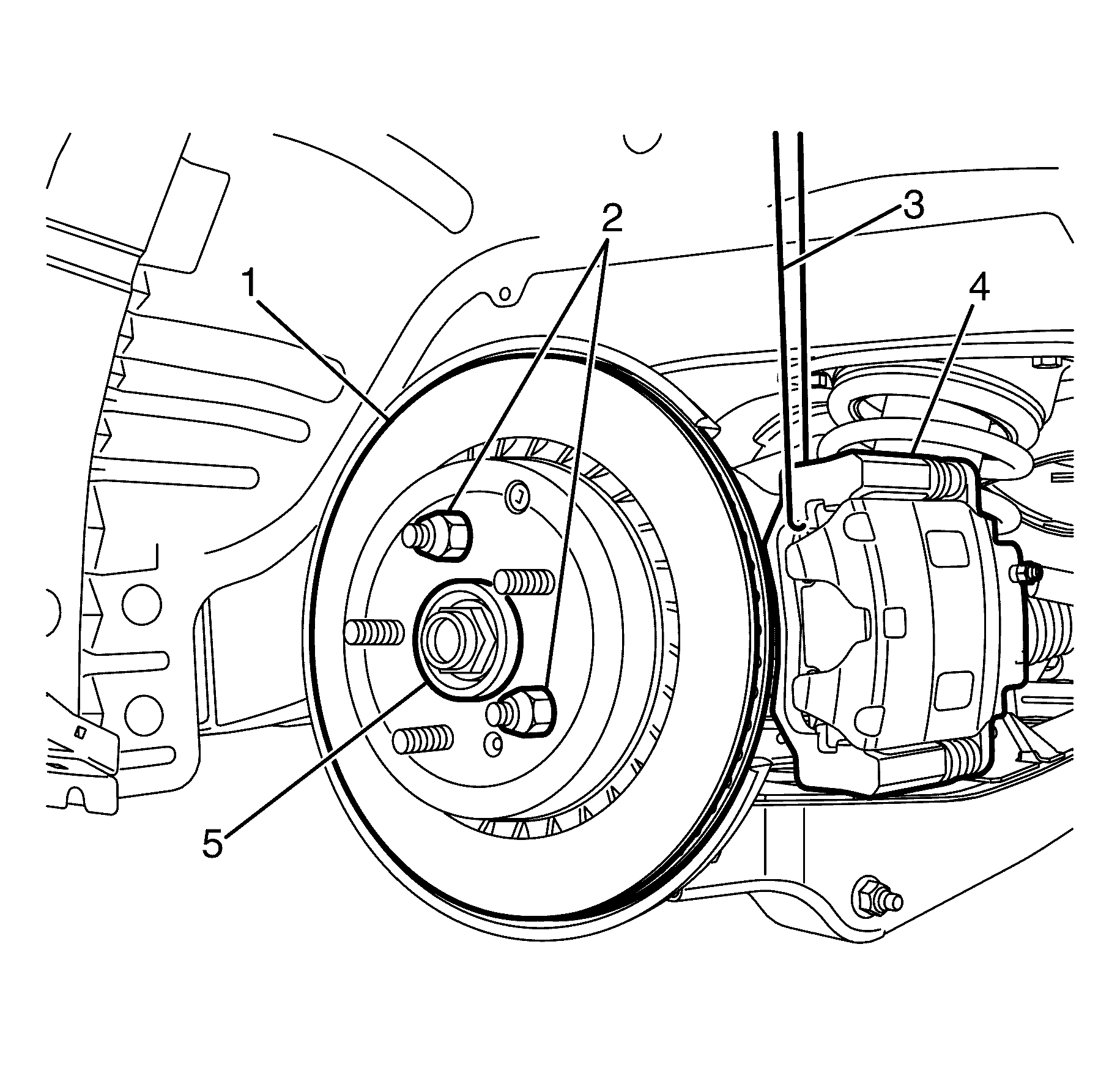
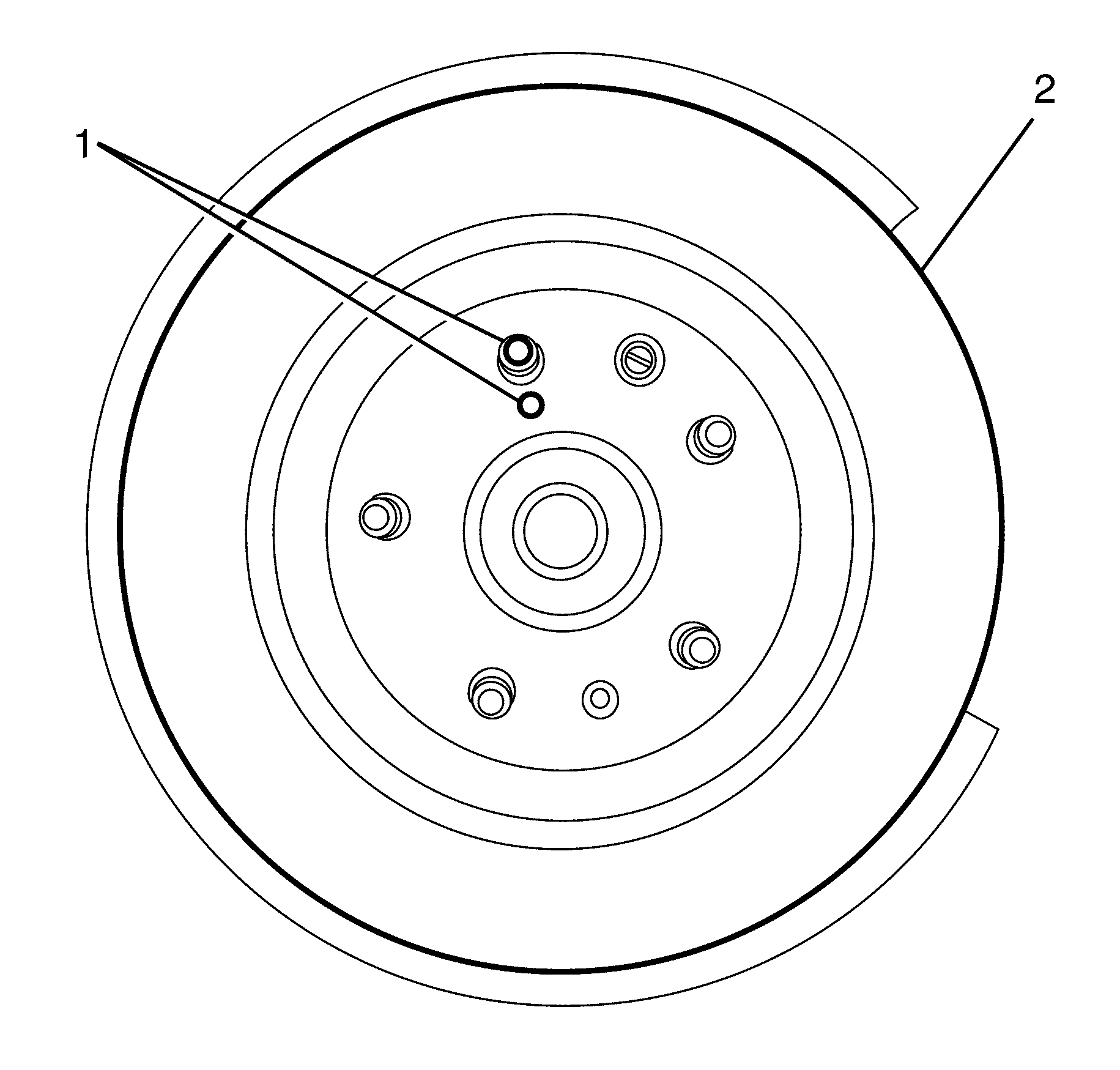
Important: The brake disc to hub relationship is indexed during production. Mark the relationship of the brake disc to a wheel stud end for installation to minimise the potential of brake shudder.
Important: If the brake disc is being removed to be machined or replaced to rectify brake shudder, or if brake disc to hub matching is not evident, the brake disc to the hub must be indexed. Refer to Brake Rotor Assembled Lateral Runout Correction - Indexing .
Installation Procedure
- Clean any rust or corrosion from the mating surface of the hub/axle flange and mounting surface of the brake disc.
- Inspect the mating surfaces of the hub/axle flange and the brake disc to make sure that there are no foreign particles or debris remaining.
- Install the brake disc (2) to the hub/axle flange. Use the matchmark (1) made prior to removal for correct orientation to the flange.
- If the brake disc was removed and installed as part of a brake system repair, measure the assembled lateral runout (LRO) of the brake disc to make sure optimum performance of the disc brakes. Refer to Brake Rotor Assembled Lateral Runout Measurement .
- If the brake disc assembled LRO measurement exceeds the specification, bring the LRO to within specifications. Refer to Brake Rotor Assembled Lateral Runout Correction .
- Remove the heavy mechanic's wire, or equivalent support (1) from the brake caliper (2).
- Install the brake caliper assembly (1) to the knuckle (3).
- Install the NEW brake caliper anchor plate to knuckle retaining bolts (2).
- Install the rear wheels. Refer to Tire and Wheel Removal and Installation .
- Lower the vehicle to the ground.
- With the engine OFF, gradually apply the brake pedal to approximately 2/3 of its travel distance.
- Slowly release the brake pedal.
- Repeat steps 11 and 12 until a firm brake pedal is obtained. This will correctly seat the brake caliper pistons and brake pads.
- Fill the master cylinder reservoir to the correct level. Refer to Master Cylinder Reservoir Filling .
- If the brake disc was refinished or replaced, or if new brake pads were installed, burnish the brake pads and brake discs. Refer to Brake Pad and Rotor Burnishing .
Caution: Refer to Safety Glasses Caution in the Preface section.
Caution: Refer to Vehicle Lifting Caution in the Preface section.
Caution: Refer to Brake Dust Caution in the Preface section.
Caution: Refer to Brake Fluid Caution in the Preface section.
Caution: Refer to Brake Fluid Irritant Caution in the Preface section.
Notice: Refer to Adding Fluid to the Brake System Notice in the Preface section.
Notice: Refer to Brake Fluid Effects on Paint and Electrical Components Notice in the Preface section.
Important: Whenever the brake disc has been separated from the hub/axle flange, any rust or contaminants should be cleaned from the hub/axle flange and the brake disc mating surfaces. Failure to do this may result in too much assembled lateral runout (LRO) of the brake disc, which may lead to brake pulsation.

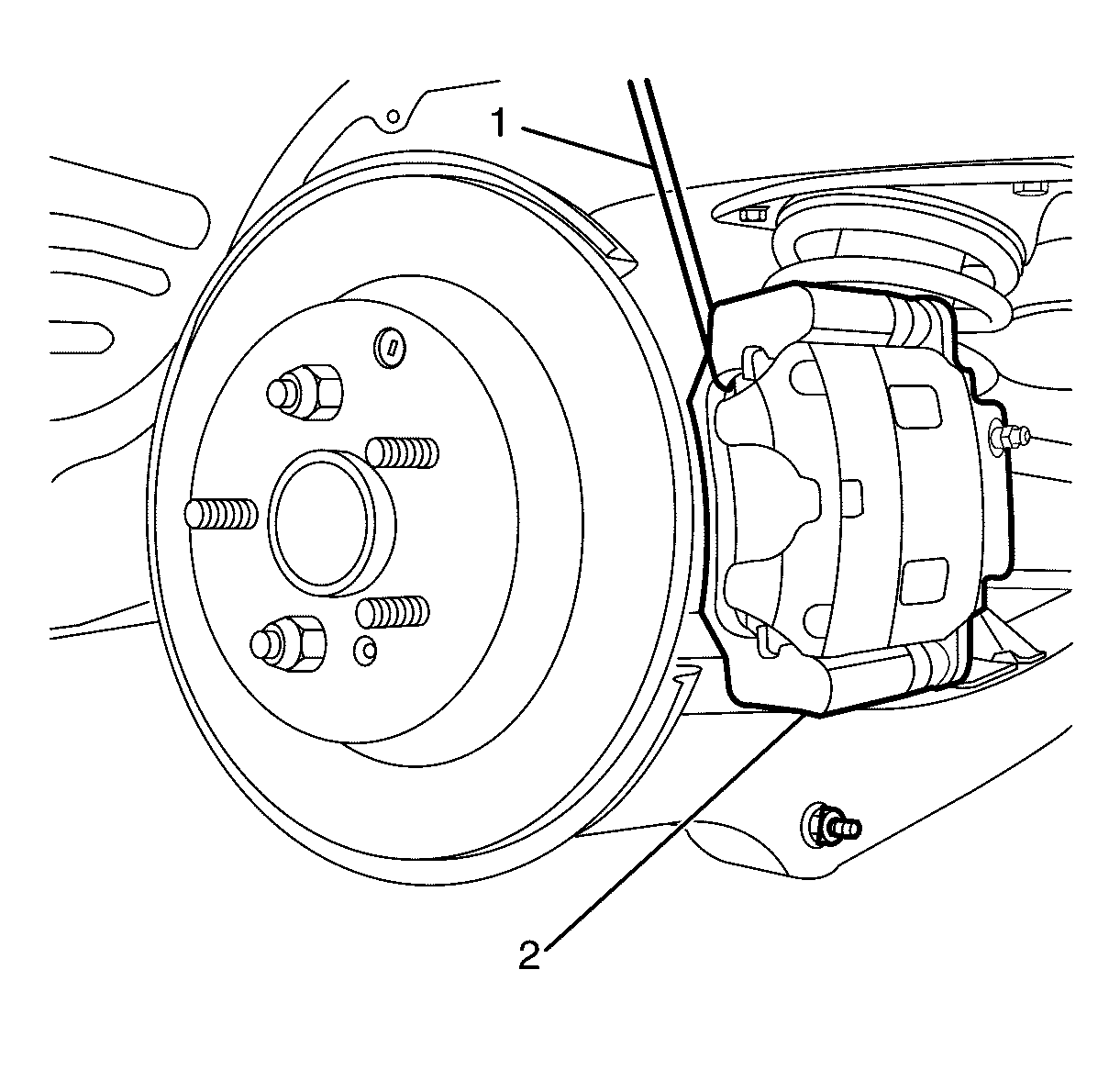

Notice: Make sure the brake hose is not twisted or kinked after installation. Damage to the hose could result.
Notice: Refer to Fastener Notice in the Preface section.
Tighten
Tighten the bolts to 110 Nm (82 lb ft).
Rear Brake Rotor Replacement CSV HSV VXR8
Removal Procedure
- Inspect the fluid level in the brake master cylinder reservoir (2).
- Raise and support the vehicle. Refer to Lifting and Jacking the Vehicle .
- Remove the rear wheels. Refer to Tire and Wheel Removal and Installation .
- Remove the rear brake caliper. Refer to Rear Brake Caliper Replacement .
- Support the brake caliper with heavy mechanic's wire, or equivalent.
- Matchmark the position of the brake rotor to the wheel studs.
- Remove the brake rotor.
Caution: Refer to Safety Glasses Caution in the Preface section.
Caution: Refer to Brake Fluid Caution in the Preface section.
Caution: Refer to Vehicle Lifting Caution in the Preface section.
Caution: Refer to Brake Dust Caution in the Preface section.
Caution: Refer to Brake Fluid Irritant Caution in the Preface section.
Notice: Refer to Brake Fluid Effects on Paint and Electrical Components Notice in the Preface section.
Notice: When adding fluid to the brake master cylinder reservoir, use only Holden specification number HN 1796 (Super DOT 4/DOT 4 Plus) brake fluid from a clean, sealed brake fluid container. The use of any type of fluid other than the recommended type of brake fluid may cause contamination which may result in damage to the internal rubber seals and/or rubber linings of hydraulic brake system components.
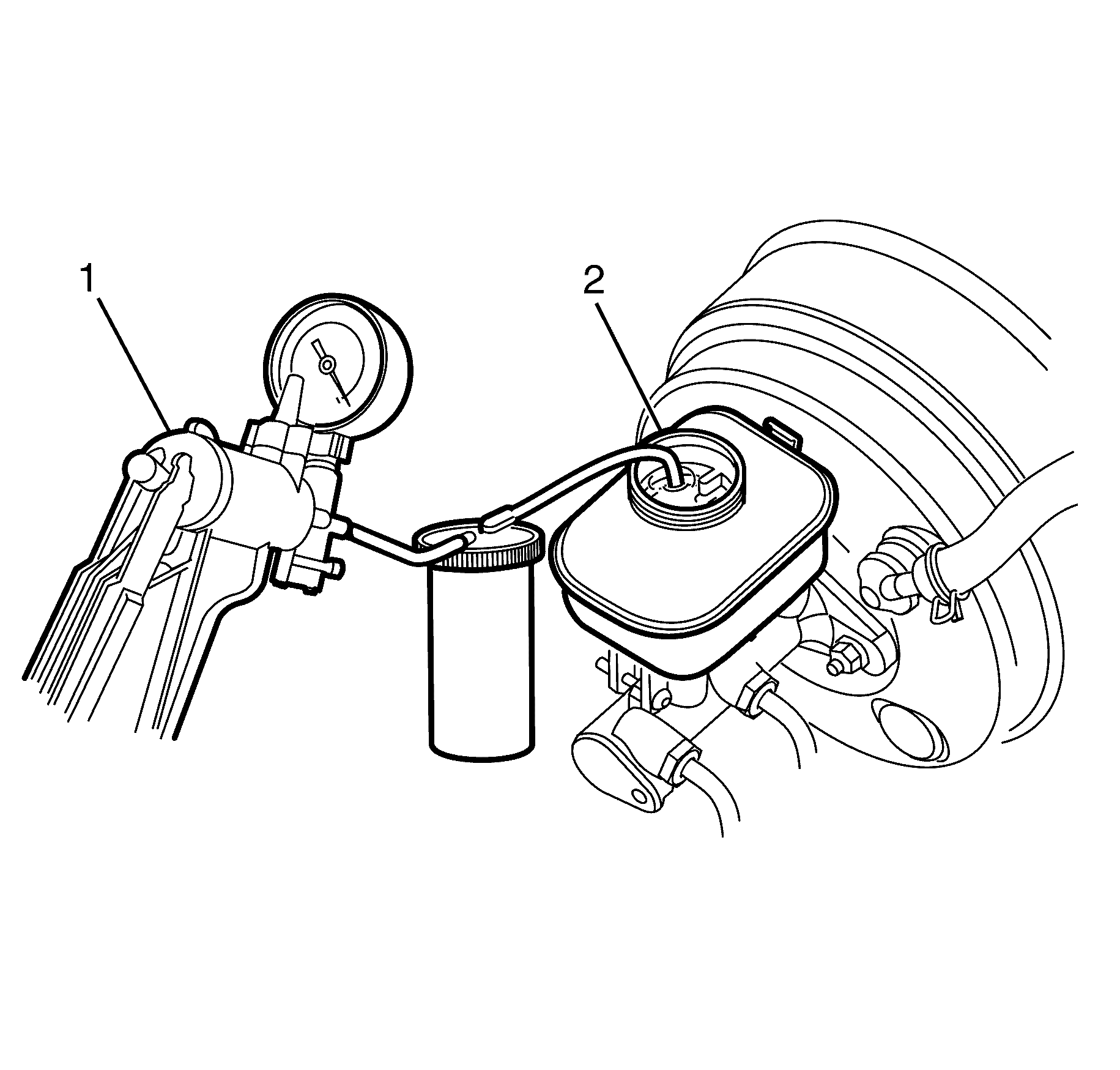
| • | If the brake fluid level is midway between the maximum fill level and the minimum allowable level, no brake fluid needs to be removed from the master cylinder reservoir before proceeding. |
| Important: DO NOT completely empty the master cylinder reservoir or remove any brake lines otherwise complete bleeding of the braking system will be necessary. |
| Important: DO NOT re use the removed fluid. |
| • | If the brake fluid level is higher than midway between the maximum fill level and the minimum allowable level, syphon the brake fluid to the midway point using a hand vacuum pump (1) before proceeding. |
Important: DO NOT disconnect the hydraulic brake flexible hose from the brake caliper otherwise complete bleeding of the braking system will be necessary.
Important: Nuts with micro-encapsulated thread sealant must be discarded after removal.
Notice: Support the brake caliper with heavy mechanic wire, or equivalent, whenever it is separated from its mount and the hydraulic flexible brake hose is still connected. Failure to support the caliper in this manner will cause the flexible brake hose to bear the weight of the caliper, which may cause damage to the brake hose and in turn may cause a brake fluid leak.
Important: The brake rotor to hub relationship is indexed during production. Mark the relationship of the brake rotor to a wheel stud end for installation to minimise the potential of brake shudder.
Important: If the brake rotor is being removed to be machined or replaced to rectify brake shudder, or if brake rotor to hub matching is not evident, the brake rotor to the hub must be indexed. Refer to Brake Rotor Assembled Lateral Runout Correction - Indexing .
Installation Procedure
- Clean any rust or corrosion from the mating surface of the hub/axle flange and mounting surface of the brake rotor.
- Inspect the mating surfaces of the hub/axle flange and the brake rotor to make sure that there are no foreign particles or debris remaining.
- Install the brake rotor to the hub/axle flange.
- If the brake rotor was removed and installed as part of a brake system repair, measure the assembled lateral runout (LRO) of the brake rotor to make sure optimum performance of the disc brakes. Refer to Brake Rotor Assembled Lateral Runout Measurement .
- If the brake rotor assembled LRO measurement exceeds the specification, bring the LRO to within specifications. Refer to Brake Rotor Assembled Lateral Runout Correction .
- Remove the heavy mechanic's wire, or equivalent support from the brake caliper.
- Install the brake caliper. Refer to Rear Brake Caliper Replacement .
- Install the rear wheels. Refer to Tire and Wheel Removal and Installation .
- Lower the vehicle to the ground.
- With the Ignition Off, gradually apply the brake pedal to approximately 2/3 of its travel distance.
- Slowly release the brake pedal.
- Repeat steps 11 and 12 until a firm brake pedal application is obtained. This will correctly seat the brake caliper pistons and brake pads.
- Fill the master cylinder reservoir to the correct level. Refer to Master Cylinder Reservoir Filling .
- If the brake rotor was refinished or replaced, or if new brake pads were installed, burnish the brake pads and brake rotor. Refer to Brake Pad and Rotor Burnishing .
Important: Whenever the brake rotor has been separated from the hub/axle flange, any rust or contaminants should be cleaned from the hub/axle flange and the brake rotor mating surfaces. Failure to do this may result in excessive assembled lateral runout (LRO) of the brake rotor, which could lead to brake pulsation.
Important: Use the matchmark made prior to removal for correct orientation to the flange.
Notice: Make sure the brake hose is not twisted or kinked after installation. Damage to the hose could result.
Rear Brake Rotor Replacement RHD
Removal Procedure
- Inspect the fluid level in the brake master cylinder reservoir (2).
- Raise and support the vehicle. Refer to Lifting and Jacking the Vehicle .
- Remove the rear wheels. Refer to Tire and Wheel Removal and Installation .
- Install two wheel nuts in reverse (3) to opposite wheel studs to retain the brake disc to the hub.
- Install large G-clamp over the body of the brake caliper (1).
- Tighten the G-clamp until the brake caliper piston bottoms out in the brake caliper bore.
- Remove the G-clamp from the brake caliper (1).
- Remove the brake caliper anchor plate to knuckle retaining bolts (1).
- Remove the brake caliper (2) from the knuckle (3).
- Support the brake caliper (1) with heavy mechanic's wire, or equivalent (2).
- Remove the two wheel nuts (4) retaining the brake disc (3) to the hub (5).
- Matchmark the position of the brake disc (2) to the wheel studs (1).
- Remove the brake disc (2).
Caution: Refer to Safety Glasses Caution in the Preface section.
Caution: Refer to Vehicle Lifting Caution in the Preface section.
Caution: Refer to Brake Dust Caution in the Preface section.
Caution: Refer to Brake Fluid Caution in the Preface section.
Caution: Refer to Brake Fluid Irritant Caution in the Preface section.
Notice: Refer to Adding Fluid to the Brake System Notice in the Preface section.
Notice: Refer to Brake Fluid Effects on Paint and Electrical Components Notice in the Preface section.

| • | If the brake fluid level is midway between the maximum fill level and the minimum allowable level, no brake fluid needs to be removed from the master cylinder reservoir (2) before proceeding. |
| Important: DO NOT completely empty the master cylinder reservoir (2) or remove any brake lines otherwise complete bleeding of the braking system will be necessary. |
| Important: DO NOT re use the removed fluid. |
| • | If the brake fluid level is higher than midway between the maximum fill level and the minimum allowable level, syphon the brake fluid to the midway point using a hand vacuum pump (1) before proceeding. |
| Important: Make sure the park brake is fully released. |

Important: Position the ends of the G-clamp against the rear of the brake caliper (1) and against the outboard brake pad (2).

Important: Bolts with micro-encapsulated thread sealant must be discarded after removal.
Important: Make sure all the bolt holes are thoroughly cleaned and all micro-encapsulated thread sealant is removed.
Discard the bolts.
Clean the bolt holes.
Important: DO NOT disconnect the hydraulic brake flexible hose from the brake caliper otherwise complete bleeding of the braking system will be necessary.
Notice: Refer to Brake Caliper Notice in the Preface section.


Important: The brake disc to hub relationship is indexed during production. Mark the relationship of the brake disc to a wheel stud end for installation to minimise the potential of brake shudder.
Important: If the brake disc is being removed to be machined or replaced to rectify brake shudder, or if brake disc to hub matching is not evident, the brake disc to the hub must be indexed. Refer to Brake Rotor Assembled Lateral Runout Correction - Indexing .
Installation Procedure
- Clean any rust or corrosion from the mating surface of the hub/axle flange and mounting surface of the brake disc.
- Inspect the mating surfaces of the hub/axle flange and the brake disc to make sure that there are no foreign particles or debris remaining.
- Install the brake disc (2) to the hub/axle flange. Use the matchmark (1) made prior to removal for correct orientation to the flange.
- If the brake disc was removed and installed as part of a brake system repair, measure the assembled lateral runout (LRO) of the brake disc to make sure optimum performance of the disc brakes. Refer to Brake Rotor Assembled Lateral Runout Measurement .
- If the brake disc assembled LRO measurement exceeds the specification, bring the LRO to within specifications. Refer to Brake Rotor Assembled Lateral Runout Correction .
- Remove the heavy mechanic's wire or equivalent support (2) from the brake caliper (1).
- Install the brake caliper assembly (1) to the knuckle (3).
- Install the NEW brake caliper anchor plate to knuckle retaining bolts (2).
- Install the rear wheels. Refer to Tire and Wheel Removal and Installation .
- Lower the vehicle to the ground.
- With the engine OFF, gradually apply the brake pedal to approximately 2/3 of its travel distance.
- Slowly release the brake pedal.
- Repeat steps 11 and 12 until a firm brake pedal is obtained. This will correctly seat the brake caliper pistons and brake pads.
- Fill the master cylinder reservoir to the correct level. Refer to Master Cylinder Reservoir Filling .
- If the brake disc was refinished or replaced, or if new brake pads were installed, burnish the brake pads and brake discs. Refer to Brake Pad and Rotor Burnishing .
Caution: Refer to Safety Glasses Caution in the Preface section.
Caution: Refer to Vehicle Lifting Caution in the Preface section.
Caution: Refer to Brake Dust Caution in the Preface section.
Caution: Refer to Brake Fluid Caution in the Preface section.
Caution: Refer to Brake Fluid Irritant Caution in the Preface section.
Notice: Refer to Adding Fluid to the Brake System Notice in the Preface section.
Notice: Refer to Brake Fluid Effects on Paint and Electrical Components Notice in the Preface section.
Important: Whenever the brake disc has been separated from the hub/axle flange, any rust or contaminants should be cleaned from the hub/axle flange and the brake disc mating surfaces. Failure to do this may result in too much assembled lateral runout (LRO) of the brake disc, which may lead to brake pulsation.



Notice: Make sure the brake hose is not twisted or kinked after installation. Damage to the hose could result.
Notice: Refer to Fastener Notice in the Preface section.
Tighten
Tighten the bolts to 110 Nm (82 lb ft).
